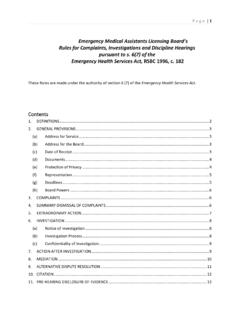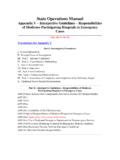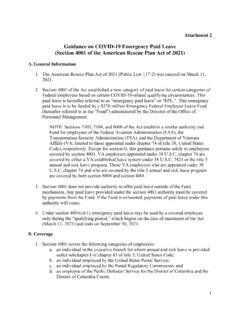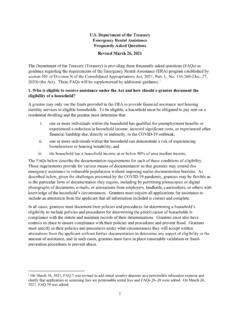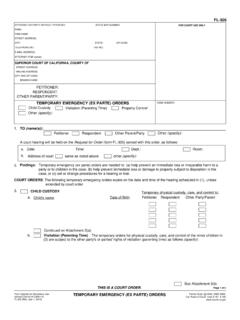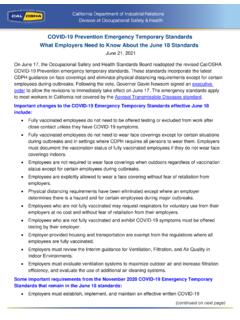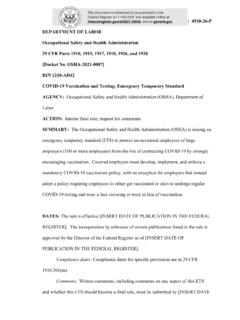Transcription of 16VAC25-220, Emergency Temporary Standard Infectious ...
1 Page | 1 , Emergency Temporary Standard220-16 VAC25 Infectious Disease Prevention: SARS-CoV-2 Virus That Causes COVID-19 As Adopted by the Safety and Health Codes Board on July 15, 2020 VIRGINIA OCCUPATIONAL SAFETY AND HEALTH (VOSH) PROGRAM VIRGINIA DEPARTMENT OF LABOR AND INDUSTRY (DOLI) Effective Date: July 27, 2020 16 VAC25-220 Page | 2 Emergency Temporary Standard Infectious Disease Prevention: SARS-CoV-2 Virus That Causes COVID-19 16 VAC25-220 16 VAC25-220-10. Purpose, scope, and applicability. A. This Emergency Temporary Standard is designed to establish requirements for employers to control, prevent, and mitigate the spread of SARS-CoV-2, the virus that causes coronavirus disease 2019 (COVID-19) to and among employees and employers. B. This Standard shall not be extended or amended without public participation in accordance with the Virginia Administrative Process Act ( et seq.)
2 Of the Code of Virginia) and 16 VAC25-60-170. C. This Standard is adopted in accordance with subdivision 6 a of of the Code of Virginia and shall apply to every employer, employee, and place of employment in the Commonwealth of Virginia within the jurisdiction of the VOSH program as described in 16 VAC25-60-20 and 16 VAC25-60-30. D. This Standard is designed to supplement and enhance existing VOSH laws, rules, regulations, and standards applicable directly or indirectly to SARS-CoV-2 virus or COVID-19 disease-related hazards such as, but not limited to, those dealing with personal protective equipment, respiratory protective equipment, sanitation, access to employee exposure and medical records, occupational exposure to hazardous chemicals in laboratories, hazard communication, A of the Code of Virginia, etc.
3 Should this Standard conflict with an Page | 3 existing VOSH rule, regulation, or Standard , the more stringent requirement from an occupational safety and health hazard prevention standpoint shall apply. E. Application of this Standard to a place of employment will be based on the exposure risk level presented by SARS-CoV-2 virus-related and COVID-19 disease-related hazards present or job tasks undertaken by employees at the place of employment as defined in this Standard ( , very high, high, medium, and lower risk levels). 1. It is recognized that various hazards or job tasks at the same place of employment can be designated as very high, high, medium, or lower exposure risk for purposes of application of the requirements of this Standard . It is further recognized that various required job tasks prohibit an employee from being able to observe physical distancing from other persons.
4 2. Factors that shall be considered in determining exposure risk level include, but are not limited to: a. The job tasks being undertaken, the work environment ( indoors or outdoors), the known or suspected presence of the SARS-CoV-2 virus, the presence of a person known or suspected to be infected with the SARS-CoV-2 virus, the number of employees and other persons in relation to the size of the work area, the working distance between employees and other employees or persons, and the duration and frequency of employee exposure through contact inside of six feet with other employees or persons ( , including shift work exceeding 8 hours per day); and Page | 4 b. The type of hazards encountered, including potential exposure to the airborne transmission of SARS-CoV-2 virus; contact with contaminated surfaces or objects, such as tools, workstations, or break room tables, and shared spaces such as shared workstations, break rooms, locker rooms, and entrances and exits to the facility; shared work vehicles; and industries or places of employment where employer sponsored shared transportation is a common practice, such as ride-share vans or shuttle vehicles, car-pools, and public transportation, etc.
5 F. This Standard shall not conflict with requirements and guidelines applicable to businesses set out in any applicable Virginia executive order or order of public health Emergency . G. 1. To the extent that an employer actually complies with a recommendation contained in CDC guidelines, whether mandatory or non-mandatory, to mitigate SARS-CoV-2 virus and COVID-19 disease related hazards or job tasks addressed by this Standard , and provided that the CDC recommendation provides equivalent or greater protection than provided by a provision of this Standard , the employer's actions shall be considered in compliance with this Standard . An employer's actual compliance with a recommendation contained in CDC guidelines, whether mandatory or non-mandatory, to mitigate SARS-COV-2 and COVID19 related hazards or job tasks addressed by this Standard shall be considered evidence of good faith in any enforcement proceeding related to this Standard .
6 2. A public or private institution of higher education that has received certification from the State Council of Higher Education of Virginia that the institution s re-opening plans are in compliance with guidance documents, whether mandatory or non-mandatory, developed by the Governor s Office in conjunction with the Virginia Department of Health shall be considered in Page | 5 compliance with this Standard , provided the institution operates in compliance with its certified reopening plans and the certified reopening plans provide equivalent or greater levels of employee protection than this Standard . A public school division or private school that submits its plans to the Virginia Department of Education to move to Phase II and Phase III that are aligned with CDC guidance for reopening of schools that provide equivalent or greater levels of employee protection than a provision of this Standard and who operate in compliance with the public school division s or private school s submitted plans shall be considered in compliance with this Standard .
7 An institution s actual compliance with recommendations contained in CDC guidelines or the Virginia Department of Education guidance, whether mandatory or non-mandatory, to mitigate SARS-CoV-2 and COVID-19 related hazards or job tasks addressed by this Standard shall be considered evidence of good faith in any enforcement proceeding related to this Standard . H. Nothing in the Standard shall be construed to require employers to conduct contact tracing of the SARS-CoV-2 virus or COVID-19 disease. 16 VAC25-220-20. Effective and expiration dates. This Emergency Temporary Standard shall take immediate effect July 27, 2020, upon publication in a newspaper of general circulation, published in the City of Richmond, Virginia. With the exception of 16 VAC25-220-80 B 10 regarding training required on Infectious disease preparedness and response plans, the training requirements in 16 VAC25-220-80 shall take effect on August 26, 2020.
8 The training requirements under 16 VAC25-220-80 B 10 shall take effect on September 25, 2020. The requirements for 16 VAC25-220-70 shall take effect on September 25, 2020. Page | 6 This Emergency Temporary Standard shall expire (i) within six months of its effective date, upon expiration of the Governor s State of Emergency , or when superseded by a permanent Standard , whichever occurs first or (ii) when repealed by the Virginia Safety and Health Codes Board. 16 VAC25-220-30. Definitions. The following words and terms when used in this Standard shall have the following meanings unless the context clearly indicates otherwise: "Administrative control means any procedure that significantly limits daily exposure to SARS-CoV-2 virus and COVID-19 disease related workplace hazards and job tasks by control or manipulation of the work schedule or manner in which work is performed.
9 The use of personal protective equipment is not considered a means of administrative control. "Airborne infection isolation room" or "AIIR, formerly a negative pressure isolation room, means a single-occupancy patient-care room used to isolate persons with a suspected or confirmed airborne Infectious disease. Environmental factors are controlled in AIIRs to minimize the transmission of Infectious agents that are usually transmitted from person to person by droplet nuclei associated with coughing or aerosolization of contaminated fluids. AIIRs provide (i) negative pressure in the room so that air flows under the door gap into the room, (ii) an air flow rate of 6-12 air changes per hour (ACH) (6 ACH for existing structures, 12 ACH for new construction or renovation), and (iii) direct exhaust of air from the room to the outside of the building or recirculation of air through a High Efficiency Particulate Air (HEPA) filter before returning to circulation.
10 Page | 7 "Asymptomatic means a person who does not have symptoms. "Building or facility owner means the legal entity, including a lessee, that exercises control over management and record keeping functions relating to a building or facility in which activities covered by this Standard take place. "CDC means Centers for Disease Control and Prevention. "Cleaning means the removal of dirt and impurities, including germs, from surfaces. Cleaning alone does not kill germs. But by removing the germs, cleaning decreases their number and therefore any risk of spreading infection. "Community transmission, also called "community spread, means people have been infected with SARS-CoV-2 in an area, including some who are not sure how or where they became infected. The level of community transmission is classified by the CDC as: 1. "No to minimal where there is evidence of isolated cases or limited community transmission, case investigations are underway, and no evidence of exposure in large communal settings ( , healthcare facilities, schools, mass gatherings, etc.)







